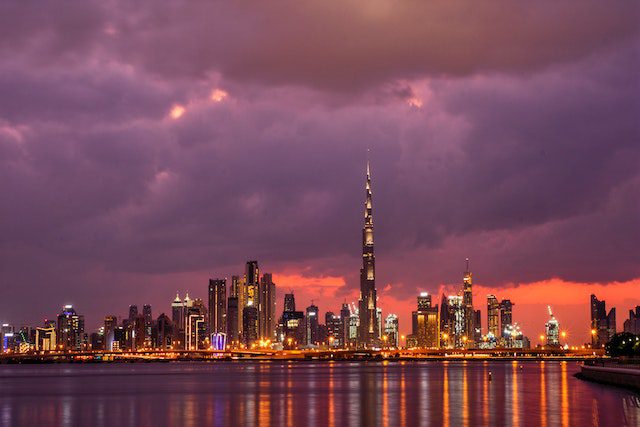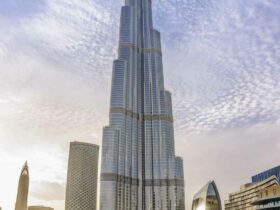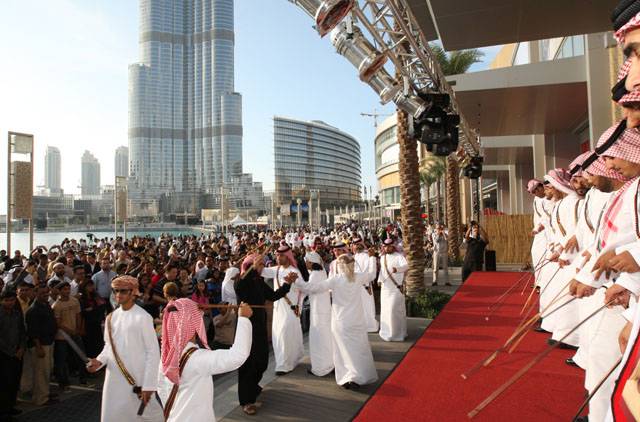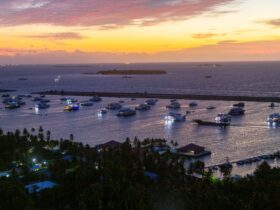In the heart of Dubai, a city known for its modern wonders, there stands a towering giant that has captured the world’s imagination. The Burj Khalifa, with its gleaming spire, seems to reach out and touch the very heavens, its story steeped in history and shrouded in an air of mystery.
A symbol of ambition and innovation, this modern marvel has transformed the skyline of Dubai, and its tale is one that weaves together the threads of architecture, engineering, and the dreams of a nation. Let’s embark on a journey to unravel the secrets and stories behind the Burj Khalifa, a structure that seems to defy both gravity and expectation.
Planning and Beginning:
In the early 2000s, Dubai had big dreams of becoming a global hub for business and tourism. That’s when the planning for the Burj Khalifa began in 2003. A famous architecture firm called Skidmore, Owings & Merrill was the brains behind the design. Construction officially started in 2004.
You May Also Like These
Reason for Building Burj Khalifa:

Dubai wanted to show the world it could be a top-notch destination. The Burj Khalifa was supposed to be a symbol of that ambition. It’s also a place for business and culture to thrive.
Why Its Named Burj Khalifa And How Long It Took To Complete
Originally, it was named the Burj Dubai (Dubai Tower). But later, it was renamed to honor Sheikh Khalifa bin Zayed Al Nahyan, who’s the President of the United Arab Emirates. The construction was a massive project that took six years to finish, and it was officially opened on January 4, 2010.
Why It Took 6 Long Years To Built
The Burj Khalifa took six years to build due to several factors, including the following:
- Sheer Height: The Burj Khalifa is an incredibly tall structure. The greater the height of a building, the more complex the construction process becomes. Each floor had to be meticulously designed and built to ensure its structural integrity and safety.
- Complex Design: The Burj Khalifa’s unique and intricate design, which was inspired by a desert flower, presented engineering challenges that required careful planning and execution.
- Foundation: A robust foundation was necessary to support a structure of this magnitude. It involved extensive excavation and the construction of a massive concrete mat to ensure stability.
- Materials and Workforce: Sourcing and transporting the necessary construction materials, as well as managing a large workforce, was a complex task. Many materials and workers had to be imported, adding logistical challenges.
- Weather Conditions: Dubai’s extreme desert climate meant construction had to contend with high daytime temperatures and cooler nights, which required special considerations and materials.
- Wind and Swaying: The height of the building made it susceptible to swaying in high winds. Advanced engineering techniques were used to counteract this challenge.
- Quality and Safety: Ensuring the highest quality and safety standards is a priority in such a monumental project. This required rigorous quality control measures and thorough safety protocols.
All of these factors, along with meticulous planning and adherence to safety regulations, contributed to the extended construction timeline. The complexity and ambition of the project made it necessary to proceed at a deliberate pace to ensure the Burj Khalifa’s successful completion without compromising quality or safety.
Cost of Construction:
The building cost a lot of money to make – approximately $1.5 billion. Dubai was ready to spend big to make this giant tower a reality.
Investors Who Invest Money On Burj Khalifa
Money for the Burj Khalifa came from many places, including local and international investors. Dubai, being a financial hotspot, attracted investments from both private individuals and the government. The Burj Khalifa project was primarily developed by Emaar Properties, a leading real estate development company in the United Arab Emirates.
The government of Dubai also played a significant role in supporting and financing the project. While there were various investors involved in Emaar Properties, the primary investment and development responsibility rested with the company itself, under the leadership of its chairman, Mohamed Alabbar. The specific details of individual investors are generally not publicly disclosed.
Labor Conditions and Wages:
As for the workers who built the tower, many of them came from South Asian countries like India, Pakistan, and Bangladesh. They played a vital role in getting the job done. The workers faced challenges during construction. Reports suggest some worked long hours and had to live in not-so-great conditions. Their wages were often lower than what’s considered fair in some other countries. Efforts have been made to improve conditions, with labor reforms and stricter rules now in place.
You May Also Like These
The Role of the Government:
The Dubai government played a crucial part in building the Burj Khalifa. They had the vision and financial support needed to turn this massive project into a reality. It was all part of their plan to make Dubai a thriving global hub.
Challenges and Difficulties:
Building a super-tall structure like the Burj Khalifa had its share of problems:
- Immense Height: Building the world’s tallest skyscraper required meticulous planning and construction for each of its numerous floors, which contributed to the time frame.
- Complex Design: The Burj Khalifa’s intricate architectural design, inspired by a desert flower, introduced engineering complexities that demanded careful execution.
- Foundation: Creating a robust foundation involved extensive excavation and the construction of a massive concrete mat to ensure structural stability.
- Logistical Challenges: Coordinating the sourcing of materials and managing a large and diverse workforce, including laborers from various countries, added to the complexity.
- Extreme Climate: Dubai’s desert climate, characterized by scorching daytime temperatures and cooler nights, posed challenges for both construction materials and work schedules.
- Wind and Swaying: The building’s extreme height made it susceptible to swaying in high winds, necessitating advanced engineering techniques to mitigate this motion.
- Quality and Safety: Maintaining high-quality construction standards and adhering to rigorous safety measures were top priorities, which contributed to the extended timeline.
Criticism Faced After Building Burj Khalifa
Here are some of the key criticisms and challenges:
- Labor Conditions: The treatment of laborers who worked on the construction of the Burj Khalifa drew substantial criticism. Reports of poor working conditions, low wages, and inadequate living conditions for the laborers, many of whom came from South Asian countries, raised concerns about labor rights and human rights.
- Environmental Impact: Building and maintaining a colossal structure like the Burj Khalifa in the desert region raised environmental concerns. The immense energy required for cooling, lighting, and other services, as well as the water consumption, had implications for sustainability in a water-scarce area.
- Cost and Financial Stability: The global financial crisis of 2008 occurred during the construction of the Burj Khalifa. Concerns were raised about the financial stability of the project and its investors, particularly Emaar Properties, as the crisis affected Dubai’s real estate market.
- Traffic Congestion: The rapid development and popularity of the Burj Khalifa area also resulted in increased traffic congestion, which drew criticism from both residents and visitors.
- Resource Allocation: Some critics argued that the massive resources allocated to building iconic structures like the Burj Khalifa could have been used to address other important societal needs, such as affordable housing and healthcare.
- Cultural and Social Impact: The Burj Khalifa’s modernity and global appeal generated debates about the preservation of Dubai’s cultural heritage and the impact of rapid urban development on the city’s social fabric.
Despite these criticisms, it’s essential to recognize that the Burj Khalifa also brought significant economic benefits to Dubai, including increased tourism, global attention, and the diversification of the city’s economy. The project served as a catalyst for further urban development and infrastructure improvements in the region. In response to some of these concerns, the Dubai government and relevant authorities have introduced labor reforms, sustainability initiatives, and urban planning strategies to address the challenges posed by such large-scale projects in the future.
You May Also Like These
Inauguration of the Burj Khalifa
The inauguration of the Burj Khalifa, which took place on January 4, 2010, was a historic and grand event that marked the official opening of the world’s tallest skyscraper.
The inauguration ceremony was a lavish and extravagant affair, befitting the iconic status of the Burj Khalifa. The event featured a dazzling display of fireworks that illuminated the night sky, creating a breathtaking visual spectacle.
Sheikh Mohammed bin Rashid Al Maktoum, the ruler of Dubai and Vice President and Prime Minister of the United Arab Emirates, played a pivotal role in the inauguration. He was the guest of honor and presided over the ceremony.
The inauguration of the Burj Khalifa garnered global attention and media coverage. News outlets from around the world covered the event, emphasizing the architectural and engineering achievement it represented.
Closing Lines
The story of the Burj Khalifa is one of monumental ambition, architectural marvels, and the indomitable spirit of a city that aimed for the stars and reached them. From its mysterious beginnings to its grand inauguration and the myriad challenges faced along the way, the Burj Khalifa stands tall as a symbol of human potential and the unyielding pursuit of excellence. As it continues to captivate the world’s imagination, it remains a testament to the enduring spirit of Dubai and a reminder that when dreams reach new heights, they can touch the sky and beyond.

































Leave a Reply
View Comments